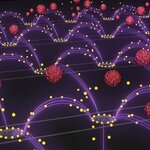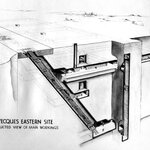Applied Physics

One thing that prevents cost-effective uptake of large-scale alternative energy, like solar and wind energy, is a lack of storage solutions. On the small scale, it is only an annoyance that battery technology has not really advanced in decades.
One thing that may help on the small scale is understanding how existing disposable Lithium batteries degrade during normal use, following on a study showing how they fail at high heat. The study follows calls from investigators in August 2015 for a safety review of all lithium battery-powered equipment on planes after a fire on board a grounded…

Engineers have harnessed the molecular machinery of living systems to power an integrated circuit from adenosine triphosphate (ATP), the energy currency of life, and they did it by integrating a conventional solid-state complementary metal-oxide-semiconductor (CMOS) integrated circuit with an artificial lipid bilayer membrane containing ATP-powered ion pumps, opening the door to creating entirely new artificial systems that contain both biological and solid-state components.
In living systems, energy is stored in potentials across lipid membranes, in this case created through the action…

Researchers have developed power paper; a new material with an outstanding ability to store energy. The material consists of nanocellulose and a conductive polymer and one sheet, 15 centimeters in diameter and a few tenths of a millimeter thick can store as much as 1 F, which is similar to the supercapacitors currently on the market. The material can be recharged hundreds of times and each charge only takes a few seconds.
The new power paper is just like regular pulp, which has to be dehydrated when making paper. The challenge is to develop an industrial-scale process for this.
It could be a…

Engineers have developed a new technology that uses an oscillating electric field to easily and quickly isolate drug-delivery nanoparticles from blood.
Nanoparticles are generally one thousand times smaller than the width of a human hair and are difficult to separate from plasma, the liquid component of blood, due to their small size and low density. Traditional methods to remove nanoparticles from plasma samples typically involve diluting the plasma, adding a high concentration sugar solution to the plasma and spinning it in a centrifuge, or attaching a targeting agent to the surface…

The V-3 “supergun” was meant to win the war for Germany.
In 1943, for the first time since World War II began, Hitler was on the back foot. Allied bombs were devastating German cities and the Fuhrer was rattled.
His proposed V-3 cannon would be the biggest gun the world had seen.
The V-3 was built in a truly enormous bunker buried deep in a chalk hill in northern France. Millions of tonnes of rock were excavated by hand and among the workers were hundreds of slave labourers. In its original conception, 25 barrels were to point at London – about 100 miles away – delivering up to one bomb…

In the late 1800's, a small, well-formed cylinder composed of platinum and a little iridium (the same alloy used in fine platinum jewelry today) was defined by the international scientific community to have a mass of exactly one kilogram.
This was not a special rock dug up from the Earth, nor a once-in-a-lifetime meteorite fallen from the heavens, but a man-made object that was bestowed this great and important property to be used by generations of scientists and non-scientists. (Happy 125th Birthday, Kilogram!)
National prototype kilogram K20, one of two prototypes stored at the US…

Nothing is more frustrating that watching that hourglass in the center of your screen while you wait for your computer to load a program or access the data you need.
Well, maybe status bars are worse. Those used to be a culture war in the political science community.
A team from the Universities of Sheffield and Leeds may have found a way to speed things up: sound. The paper in Applied Physics Letters finds that certain types of sound waves can move data quickly, using minimal power.
The world's 2.7 zettabytes (2.7 followed by 21 zeros) of data are mostly held on hard disk drives…

Using flexible organic circuits and specialized pressure sensors, researchers have created an artificial "skin" that can sense the force of static objects. Furthermore, they were able to transfer these sensory signals to the brain cells of mice in vitro using optogenetics.
For the many people around the world living with prosthetics, such a system could one day allow them to feel sensation in their artificial limbs.
To create the artificial skin, Benjamin Tee et al. developed a specialized circuit out of flexible, organic materials. It translates static pressure into digital signals that…
If you live in Indiana, or at least near Indianapolis, you should go to the Celebrate Science Indiana science festival in the Blue Ribbon Pavilion at the Indiana State Fairgrounds Saturday 3 October 2015 from 9:30am-5:30pm—it’s free.
The Celebrate Science Indiana science festival is for all ages and activities will “include robots, drone flying, DNA extraction, the analysis of art works, the taste of popcorn, the growth of plants, and the marvels of skeletons,” says Walter Jessen, Systems Biologist at Covance.
The festival will emphasize the value of STEM (Science, Technology,…

The worst nuclear disaster since the 1986 Chernobyl meltdown never should have happened, according to a new study.
In Philosophical Transactions A of the Royal Society, researchers Costas Synolakis of the USC Viterbi School of Engineering and Utku Kâno'lu of the Middle East Technical University in Turkey distilled thousands of pages of government and industry reports and hundreds of news stories, focusing on the run-up to the disaster. They found that "arrogance and ignorance," design flaws, regulatory failures and improper hazard analyses doomed the costal nuclear power plant even before the…